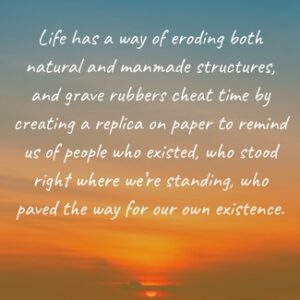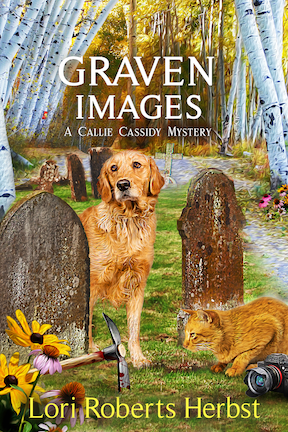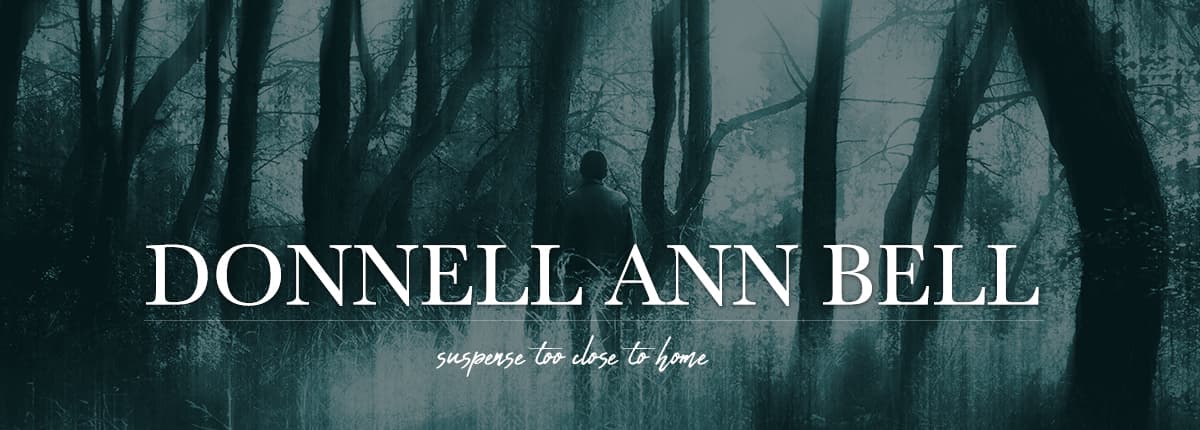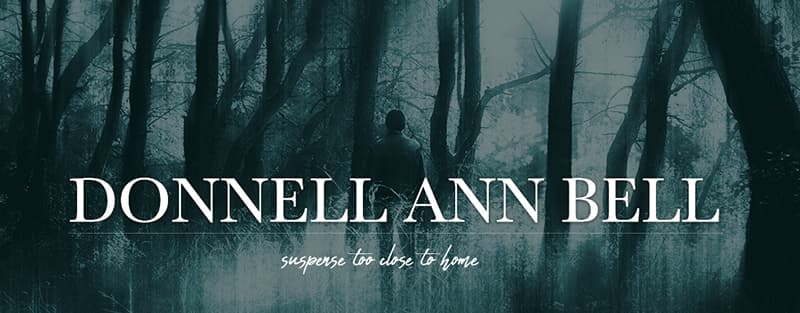A few weeks ago on my Sisters in Crime Colorado writers loop, my guest today talked about her newest release. When I read the blurb, I was not only intrigued, I thought surely that’s a misprint. I asked Lori to clarify. No misprint, folks. Please join Author Lori Roberts Herbst as she talks about the subject of her newest release. ~ Donnell
The Art of Grave Rubbing
By Lori Roberts Herbst

Lori Roberts Herbst
Excerpt from GRAVEN IMAGES, Book 6 in the Callie Cassidy Mystery series:
“For the past few years, Maggie Cassidy had become something of a hobby jumper. She’d tried her hand at knitting, cake decorating, scrapbooking, and jigsaw puzzles. Now she was immersing herself in the oddest pursuit of all: grave rubbing.
“Not grave robbing, which I thought I’d heard when she first spoke of her new pastime. No, this hobby didn’t require a shovel and the dark of night, but rather rice paper, rubbing wax, a spray bottle filled with clean water, a soft brush—and tombstones.”
Over the course of six books, my protagonist, Callie Cassidy, a former investigative photojournalist who has moved back to the small mountainside village of her youth, has discovered dead bodies in several unusual places: her own darkroom, a horse stable, and even one who fell from the catwalk of a hockey arena. So, as I was brainstorming ideas for book 6, I wanted something that fit the pattern—a unique location in which to find a body.
I’ve always been fascinated with cemeteries, especially the historical ones with tombstones hundreds of years old. I can spend hours traversing the grounds, reading people’s birth and death dates and their sometimes sad and philosophical epitaphs. All those souls. All their stories. What better place for a murder to occur?
The question became: how do I get Callie (who always finds the body) into a cemetery? She’s in her mid-forties, and I don’t want any of her family or friends dying and requiring her presence at a funeral. Finally, it came to me. Callie’s mother, the hobby jumper, could take up grave rubbing, and Callie could tag along to photograph Mom’s endeavor.
I’d heard of the grave rubbing (also called stone rubbing) in passing but didn’t know much about it, so I spent (too much) time going down the research rabbit hole. All authors know how that goes: you set aside an hour to study the process and became so engrossed that you lose an entire day.
Here are a few of the more interesting tidbits I picked up in my research quest:
The art of grave rubbing is also called frottage. I started to use the term in my book, but when I plugged it into Google for a more thorough definition, I discovered there’s a widely used slang version of the word that refers to…shall we say, a different kind of rubbing. The kind more for a steamy romance than a cozy mystery. Scratch the use of that word.
No one knows the exact origin of stone rubbing, but according to the Field Museum, which houses an extensive collection, examples date to the invention of paper, 100 A.D. or even earlier. Chinese religious scholars used rubbings to document inscriptions of the classic Confucian, Buddhist, and Daoist texts.
 Today, grave rubbing is a controversial practice. The main issue is the possibility of degradation to the grave stones. Repeated chafing from the paper and the rubbing can break down an already fragile stone, aggravating its brittle condition. Also, some view the practice as disrespectful to the dead. Tourists without the proper training and mindset can treat these sacred places as just another selfie opportunity, doing physical harm to the stone and emotional harm to the descendants of those buried there. Some cemeteries, and even some states, ban the practice to protect against the possibility of such destruction.
Today, grave rubbing is a controversial practice. The main issue is the possibility of degradation to the grave stones. Repeated chafing from the paper and the rubbing can break down an already fragile stone, aggravating its brittle condition. Also, some view the practice as disrespectful to the dead. Tourists without the proper training and mindset can treat these sacred places as just another selfie opportunity, doing physical harm to the stone and emotional harm to the descendants of those buried there. Some cemeteries, and even some states, ban the practice to protect against the possibility of such destruction.
On the other side of the argument, many historians contend that, if conducted properly, grave rubbing is the ultimate in respect. Those who engage in the practice are mostly genealogists striving to preserve the history of their ancestors. Life has a way of eroding both natural and manmade structures, and grave rubbers cheat time by creating a replica on paper to remind us of people who existed, who stood right where we’re standing, who paved the way for our own existence.
A good grave rubber understands the appropriate way to tackle the pursuit. When Callie’s mother decides to take up the activity, she goes through a training process, learning the tools and best practices to properly preserve the stone. She applies to the local Chamber of Commerce for approval. Choosing the stones carefully, she avoids graves that might be further damaged by her touch. She treats the sacred place with deference.
And most important for my plotting, she manages to maneuver Callie into the cemetery at the perfect time to discover a murder victim. I’d say that’s killing two birds with one…well, you get the idea.
About the Book: 
A photo assignment at the cemetery leads Callie Cassidy to a corpse—this one above ground. Her search for the killer unearths some long-buried secrets…
Callie’s mother is tackling a new hobby—grave rubbing. As Callie photographs her first attempt, a ghostly looking woman emerges from the trees, bleeding from a head wound and claiming to have no memory of who she is. If that’s not enough intrigue, Callie’s golden retriever and tabby cat lead her to a man lying on the ground near a tombstone—with a pickaxe jutting from his neck. Callie recognizes the dead man as the mobster dating her best friend’s mother. Did she murder her boyfriend? Could it have been the mysterious woman? Or maybe someone with ties to his crime family? Callie can’t resist investigating—and this time, Detective Raul Sanchez welcomes her assistance. Because if they can’t solve the crime soon, the town may be facing grave consequences…
About the Author:
Silver Falchion and CIBA Murder & Mayhem award-winning author Lori Roberts Herbst writes the Callie Cassidy Mystery series. A former journalism teacher and counselor, Lori spent much of her life writing, editing, and psychoanalyzing. Through thirty years of teaching journalism, advising newspaper and yearbook staffs, instructing budding photographers, and counseling teenagers, she still managed to hang on to a modicum of sanity. Then she retired and assumed her third career: author. Lori serves as Board Secretary for Sisters in Crime National. She is a member of the SinC Colorado chapter, the SinC North Dallas chapter, and the Guppy chapter, where she moderates the Cozy Gup group. Lori spent most of her life in Dallas, TX, and now lives in Colorado Springs. For more, visit her website at www.lorirobertsherbst.com.











Lori, welcome to my blog. At first I was on the side of those who viewed grave rubbing as grave disrespect (sorry about the pun), but as I considered how many artifacts and monuments have been destroyed by war or vandalism, I think *respectful* and *careful* grave rubbing may be a wonderful solution. Can’t wait to read Graven Images and learn more.
Thank you so much for hosting me, Donnell! I’ve personally never tried grave rubbing, but I’ve seen some beautiful pieces created by it!
Interesting indeed! I, too, love to spend time in old cemeteries. So many stories lie buried there.
Ha ha, Rhonda. 🙂 Grave yards do make the best settings.